إذا كنت جديدًا في مجال إدارة المشاريع، فقد تكون متحمسًا للغاية - بينما تشعر في الوقت نفسه ببعض التوتر بشأن المهمة الكبيرة التي تنتظرك والتوقعات الكبيرة من فريقك ورؤسائك.
وإذا كان لديك بعض الخبرة، فربما تشعر بالثقة في مهاراتك، ولكنك تدرك في الوقت نفسه تحديات كل مشروع جديد. أنت تعلم أيضًا أن تكييف وتعديل نهجك يؤدي إلى نجاح أكبر للمشروع ويعزز خبرتك.
سواءً كنت مبتدئًا أو محترفًا، لدينا 10 تقنيات لإدارة المشاريع لمساعدتك على النجاح في أي مشروع. وأفضل ما في الأمر؟ إنها قابلة للتطبيق في أي مجال وحجم مشروع. نراهن على أنك ستكتشف بعض الجواهر في هذه الجولة التي ستتحداك لتجربة شيء جديد. 💎
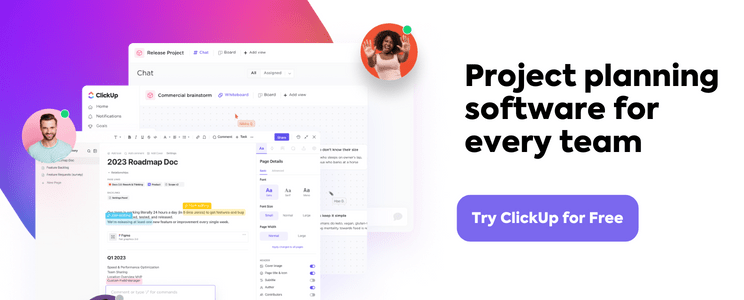
ما هي إدارة المشاريع؟
الـ معهد إدارة المشاريع (PMI) يعرّف إدارة المشروع على أنها "استخدام معارف ومهارات وأدوات وتقنيات محددة لتقديم شيء ذي قيمة للناس."
ويتضمن ذلك تحديد الحاجة إلى مشروع ما، وتحديد الأهداف التي يحتاج المشروع إلى تحقيقها، ثم الدخول في التفاصيل - تخطيط ما يجب القيام به، وتنفيذ الخطة، ومراقبة التقدم المحرز، وإدارة أي مفاجآت تظهر على طول الطريق، وأخيرًا، تسليم المشروع المكتمل.
يشرف مديرو المشاريع على العملية، ويضمنون بقاء المهام في الموعد المحدد، ويساعدون في تحقيق النتائج المرجوة من المشروع. 💯
10 أنواع من تقنيات إدارة المشاريع ## 10 أنواع من تقنيات إدارة المشاريع
لضمان إنجاز المشاريع بنجاح، أنت بحاجة إلى مجموعة متنوعة من أدوات إدارة المشاريع والتقنيات المتاحة لك.
إليك قائمة من 10 تقنيات فريدة تستحق الاستكشاف. سنقوم بتفصيل ماهيتها، وكيفية استخدامها، ومتى تستخدمها.
1. هيكل تقسيم العمل (WBS)
المشاريع معقدة بطبيعتها، ولهذا السبب فإن تقنية WBS مفيدة في مرحلة تخطيط المشروع. فهي تتيح لك تقسيم أهداف المشروع إلى مهام صغيرة قابلة للتنفيذ.
تصبح الأمور أكثر سهولة عندما تصل إلى "حزم العمل" (أصغر المهام التي لا يمكنك تقسيمها أكثر من ذلك). يمكنك تعيين مهام فردية لفريقك، وتخصيص الموارد، وتعيين المواعيد النهائية، وتتبع تقدم المشروع عند اكتمال المهام.
قوالب WBS، مثل قالب تقسيم العمل ClickUp يجعل نهج إدارة المشاريع المتطرفة أقل ترويعًا. إنه لوحة بيضاء رقمية مع الأشكال والملاحظات اللاصقة والموصلات لرسم خريطة WBS الخاصة بك. بالإضافة إلى ذلك، يمكنك دعوة فريقك للمشاركة وإجراء التغييرات في الوقت الفعلي، بحيث يتم تغطية كل التفاصيل قبل بدء المشروع.
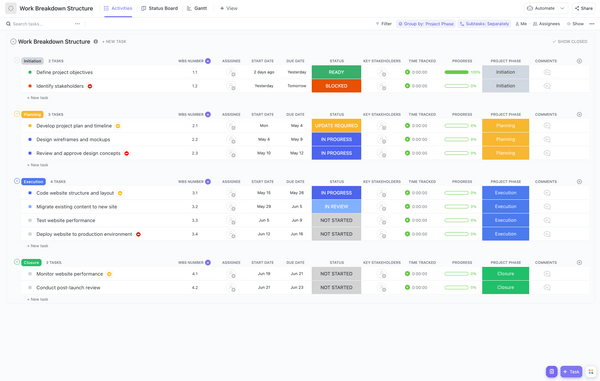
إدارة المشاريع باستخدام هيكل تقسيم العمل في طريقة عرض قائمة ClickUp
_تحقق من هذه
_مراجع/ https://clickup.com/blog/work-breakdown-structure-software// أدوات_WBS %/%href/_
!
2. الشلال
الـ تقنية الشلال هو نهج خطي ومتسلسل لإنجاز المشروع وأحد أقدم تقنيات إدارة المشاريع. ويتضمن تجميع المهام في سلسلة من المراحل وإكمال كل مرحلة قبل بدء المرحلة التالية. تتضمن هذه المراحل عادةً ما يلي:
- المتطلبات: جمع تفاصيل المنتج
- التصميم: التخطيط لكيفية بناء المنتج
- التنفيذ: اتخاذ إجراءات بشأن خططك
- الاختبار: التحقق مما إذا كان المنتج يلبي المتطلبات الأولية
- النشر: تسليم المنتج إلى العميل أو المستخدم النهائي
- الصيانة: إصلاح أي مشاكل تنشأ أثناء استخدام المنتج
على عكس المنهجية الرشيقة ، تفترض هذه التقنية أن متطلبات المشروع محددة جيدًا ومن غير المرجح أن تتغير. وينطبق هذا عادةً على مشاريع مثل تخطيط الأحداث والبناء والتصنيع ونشر الكتب.
3. سكروم
Scrum هو نوع شائع من تقنيات إدارة المشاريع الرشيقة، وغالبًا ما تستخدمه فرق تطوير البرمجيات لتنفيذ المشاريع. في Scrum، تبدأ أنت وفريق المشروع الخاص بك بإنشاء قائمة مهام رئيسية تسمى "تراكمات المنتج" 📝
في بداية "العدو السريع" - وهي مرحلة عمل قصيرة ومركزة تستمر عادةً لمدة أسبوعين (شهر واحد كحد أقصى) - يختار فريقك المهام ذات الأولوية القصوى من قائمة مهام المنتج المتراكمة. وتصبح هذه المهام المختارة (المعروفة أيضًا باسم "الأعمال المتراكمة في العدو السريع") هي محور التركيز الرئيسي لهذا العدو.
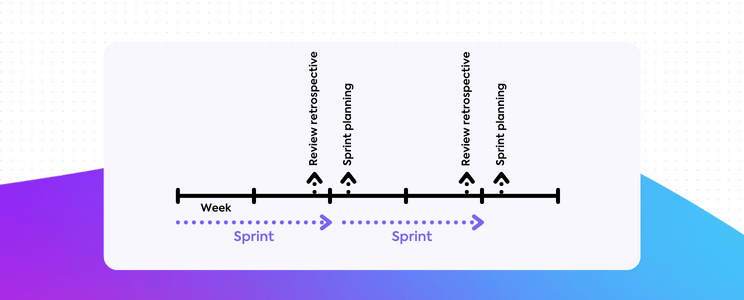
حافظ على مرونتك أثناء تنفيذك لمهامك مع فريقك
للبقاء على المسار الصحيح، سيكون لديك اجتماعات يومية (اجتماعات صباحية مدتها 15 دقيقة)، بقيادة مسؤول سكروم لمناقشة التقدم المحرز ومعالجة أي مشاكل. استخدم سكروم للمشاريع المعقدة التي قد تتغير فيها الاحتياجات بسبب تغيرات السوق أو التغذية الراجعة المستمرة، أو عندما يكون التواصل المنتظم هو المفتاح للحفاظ على سير المشروع بسلاسة.
4. كانبان
كانبان هو أسلوب رشيق متعدد الاستخدامات يستخدم في مختلف الصناعات، وذلك بفضل تصميمه البسيط للوحة لتصور مهام المشروع وحالاتها. نموذجية لوحة كانبان مقسمة إلى ثلاثة أعمدة: تنفيذ، في قيد التنفيذ، و متروك_.
للبدء، انقل العمل من قائمة مهامك الرئيسية إلى عمود للقيام، ثم إلى تحت التنفيذ عندما يتم العمل عليه، ثم إلى ترك العمل بمجرد الانتهاء منه. على عكس Scrum، لا يوجد جدول زمني صارم لوقت إنجاز المهام. ولكن لتجنب إرباك فريقك، قم بتعيين حد أقصى لعدد المهام لكل عمود، ويعرف أيضًا باسم حد العمل الجاري (WIP).

إنشاء سير العمل الرشيق وقم ببناء نظام كانبان مرن لتصور عملك وتحسين إدارة المشروع باستخدام طريقة عرض اللوحة في ClickUp طريقة عرض كانبان الرقمية في ClickUp يجعل من السهل إنشاء اللوحة وتحديثها وإدارتها عبر الإنترنت ومن أي جهاز. يمكنك إنشاء العديد من الأعمدة (مع تسميات مخصصة) كما تريد، وتعيين حدود WIP، ونقل المهام عن طريق سحبها وإفلاتها عبر الأعمدة.
تعتبر منهجية إدارة المشاريع هذه مثالية للتعامل مع العمل المستمر حيث قد تتغير الأولويات، مثل إدارة تطبيق مباشر، أو التعامل مع تذاكر الدعم، أو إدارة المدونة ومنشورات وسائل التواصل الاجتماعي.
5. مخطط جانت
مخطط جانت هو أسلوب مفيد لتصور جميع مهام مشروعك والتواريخ المهمة في لمحة سريعة. فهو يُظهر بوضوح متى تبدأ كل مهمة وتنتهي، وكيف تعتمد المهام على بعضها البعض، ويحدد المعالم الرئيسية.
بناء مخططات جانت في ClickUp بمجرد حصولك على WBS الخاص بك: أدخل مهامك، واسحبها وأفلتها على المخطط، وحدد تواريخ بدايتها ونهايتها، واربط المهام التابعة.
تحتوي طريقة عرض جانت في ClickUp أيضًا على ميزات تصور مفيدة:
- مخطط الألوان: ترميز المهام بالألوان بناءً على الأولوية والحالة
- المرشحات: عرض المهام ذات المُعيَّن والأولوية وتاريخ الاستحقاق والمزيد
- الوضع الخاص بي: يسمح لأعضاء الفريق برؤية المهام المخصصة لهم فقط
- شريط التقدم: تتبع النسبة المئوية لإنجاز مشروعك عند الانتهاء من المهام
إذا كنت تعمل على مشاريع ذات تبعيات مهام كثيرة وحيث يكون الالتزام بالمواعيد النهائية للمهام أمرًا بالغ الأهمية، فإن مخطط جانت هو الأسلوب الأمثل للمساعدة في إنجاز المهمة. 🎯
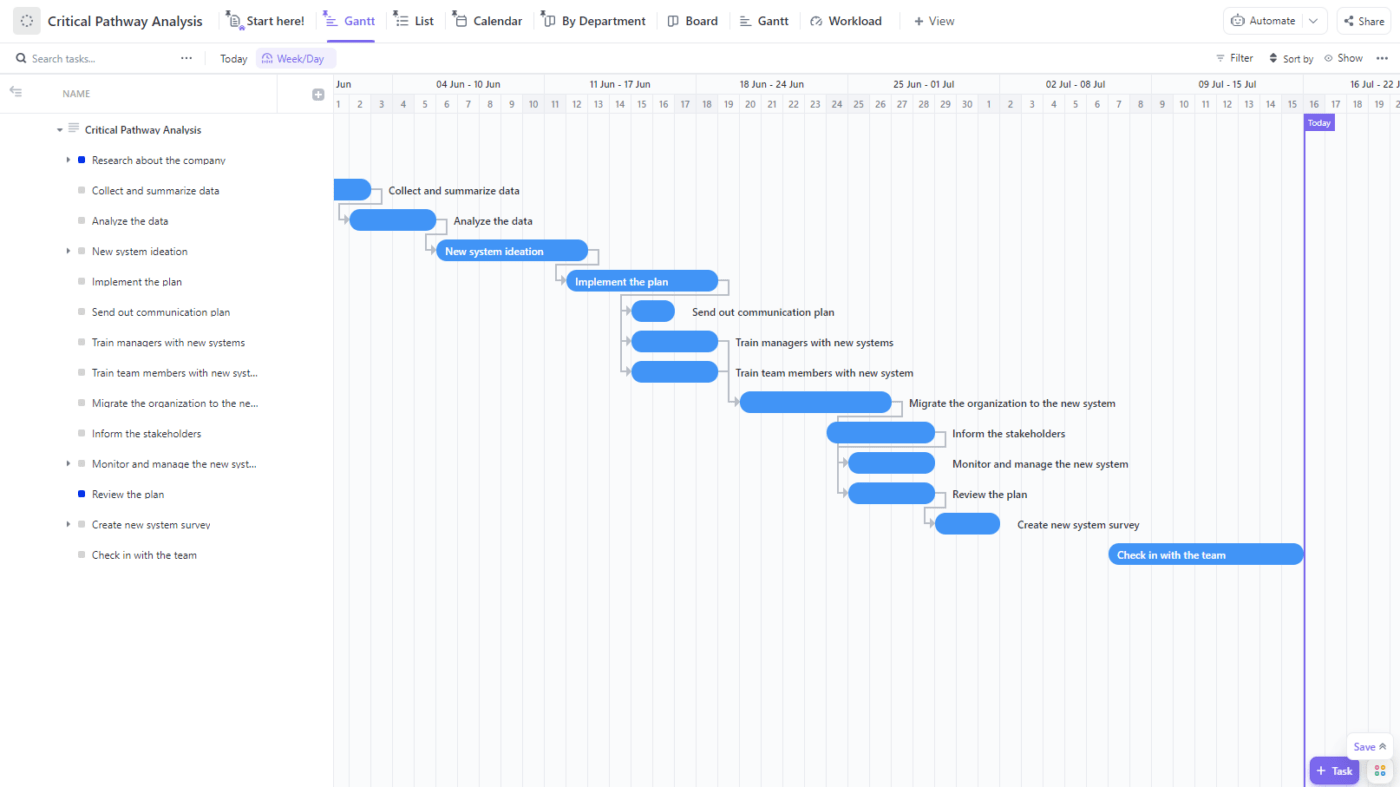
تقدير مدة كل نشاط وتكوين جدول زمني واقعي بمساعدة مخطط جانت البياني
6. طريقة المسار الحرج (CPM)
تشير طريقة المسار الحرج (CPM) إلى المسار الحرج لمشروعك بمجرد تحديد مدد المهام والتبعيات باستخدام مخطط جانت.
يتألف المسار الحرج من المهام التي ستستغرق أطول فترة لإكمالها، مما يحدد تاريخ اكتمال مشروعك. يؤدي التأخير في أي من هذه المهام إلى تأخير المشروع بأكمله. لذلك، تحتاج إلى مراقبتها عن كثب لضمان بقاء مشروعك على المسار الصحيح. 🗓️
باستخدام مخططات جانت الخاصة ب ClickUp، يمكنك الكشف عن المسار الحرج بنقرة واحدة فقط. يمكنك أيضًا رؤية "فترة "التراخي" في مهامك، وهو الوقت الإضافي الذي لديك للعمل عليها دون تمديد تاريخ انتهاء المشروع. لذا، إذا تأخرت إحدى المهام في المسار الحرج، ستتمكن بسهولة من إعادة ترتيب مهامك بحيث يمتص التأخير أي تأخير.
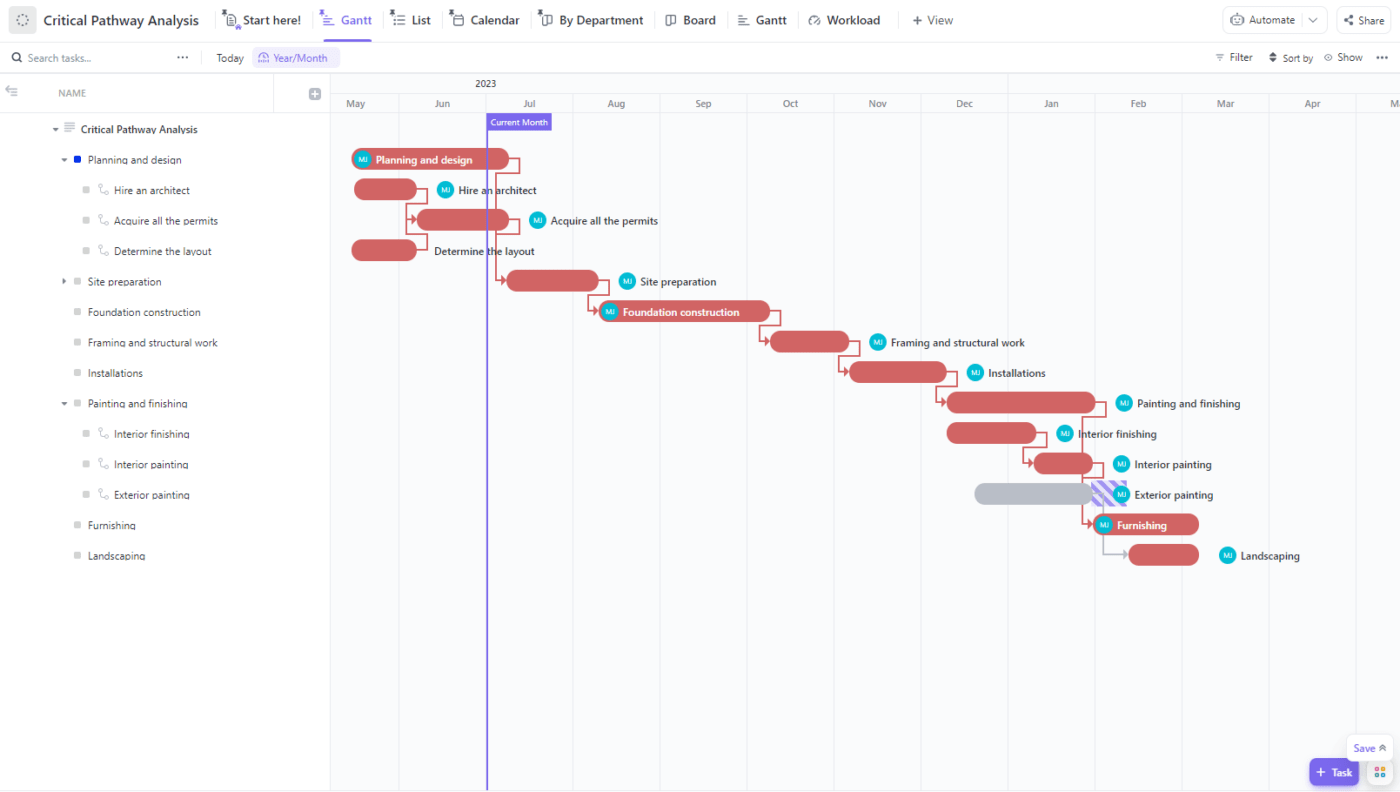
حدد المسار الحرج للمشروع وحدد فترة الركود للأنشطة المرنة غير الحرجة في طريقة عرض جانت في ClickUp
7. إدارة أصحاب المصلحة
في كل مشروع، يكون لديك أفراد لديهم مستوى معين من التأثير أو الاهتمام بالمخرجات. وهذا يعني أنك بحاجة إلى تحديد من هم هؤلاء الأشخاص قبل بدء المشروع. استخدام نماذج تخطيط أصحاب المصلحة يجعل هذه العملية سهلة.
بمجرد تحديد أصحاب المصلحة الرئيسيين، تعرف على توقعاتهم وتفضيلات التواصل معهم. وعندما يكون المشروع قيد التنفيذ، زودهم بتحديثات منتظمة وجدولة جلسات لجمع ملاحظاتهم حول القضايا الرئيسية.
كليك أب عرض تقويم الذكاء الاصطناعي يتيح لك جدولة وتتبع جميع أنشطة التواصل والمشاركة مع أصحاب المصلحة في مكان واحد. كما يمكنك مزامنته مع تقويم Google الخاص بك لتجنب التعارض في الجدولة. بالإضافة إلى ذلك، ستتلقى تذكيرات بالاجتماعات القادمة!
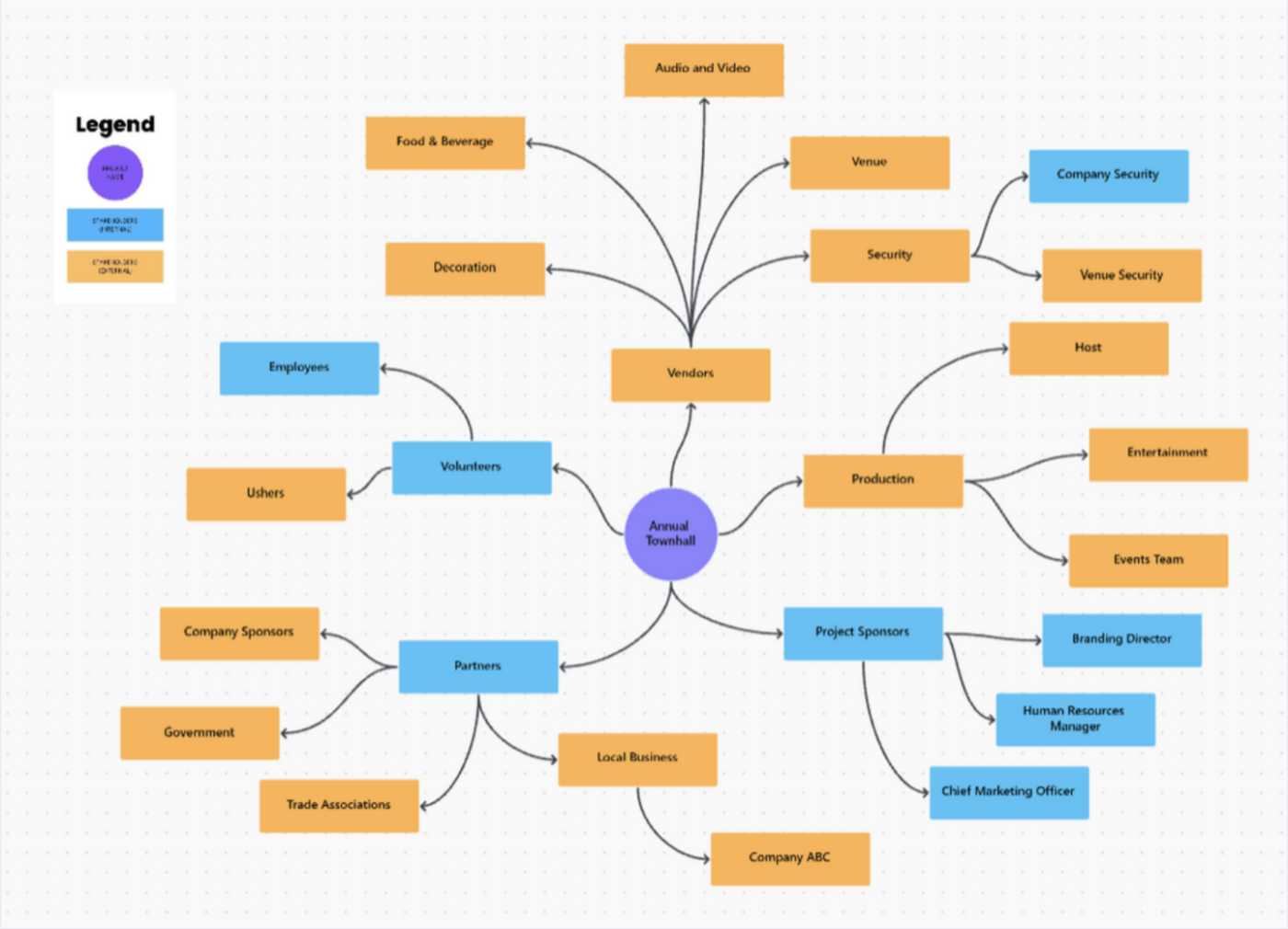
استخدام تقنيات رسم خرائط أصحاب المصلحة على لوحة ClickUp البيضاء
8. إدارة القيمة المكتسبة (EVM)
إدارة القيمة المكتسبة هي تقنية لقياس الأداء العام للمشروع من حيث الميزانية والجدول الزمني للمشروع. للتحقق من مدى جودة أداء مشروعك في أي مرحلة معينة، تحتاج إلى ثلاث قيم رئيسية:
- القيمة المخططة (PV): ما خططت لتحقيقه عند هذه النقطة
- القيمة المكتسبة (EV): ما حققته بالفعل حتى الآن
- التكلفة الفعلية (AC): ما أنفقته حتى هذه اللحظة
هذه المقاييس ضرورية لحساب المقاييس الرئيسية مثل مؤشر أداء التكلفة (CPI) ومؤشر أداء الجدول الزمني (SPI). إذا كان مؤشر أداء التكلفة (CPI) أقل من واحد، فهذا يعني أنك تجاوزت الميزانية؛ وإذا كان مؤشر أداء التكلفة (SPI) أقل من واحد، فهذا يعني أنك متأخر عن الجدول الزمني.
وهذا مفيد جدًا لإجراء تعديلات تعتمد على البيانات مثل خفض تكاليف المشروع للمضي قدمًا أو تأمين تمويل إضافي أو إعادة تخصيص الموارد لتسريع سير العمل.
احسب هذه المقاييس تلقائيًا داخل ClickUp باستخدام حقول الأرقام والصيغ. قم أيضًا بإنشاء لوحة معلومات مخصصة تعرض هذه المقاييس بصريًا و تتبع أهداف مشروعك . بهذه الطريقة، أنت و أصحاب المصلحة في المشروع سوف يستوعبون بسرعة الرؤى الرئيسية دون البحث في صفوف طويلة من تفاصيل المشروع.
9. إدارة المخاطر
تتعلق إدارة المخاطر بإدارة المخاطر المحتملة لتقليل تأثيرها على مشروعك. ابدأ بتحديد التهديدات والعوائق المحتملة مثل عوائق الميزانية، والتحولات في الجدول الزمني، وتغييرات النطاق، وفي الحالات القصوى، تقلبات السوق أو الكوارث الطبيعية. 🌪️
قم بتحليل هذه المخاطر باستخدام قالب تحليل مخاطر إدارة المشاريع من ClickUp وخطط لاستجاباتك وفقًا لذلك. أثناء المشروع، راقب هذه المخاطر باستمرار مع سجلات المخاطر لتجنب المفاجآت.
هل تحتاج إلى عصف ذهني للحلول؟ استخدم ClickUp Whiteboards أو انقر فوق الخرائط الذهنية . يساعدك رسم أفكارك على صياغة استراتيجيات قوية لمواجهة أي مخاطر تعترض طريقك.
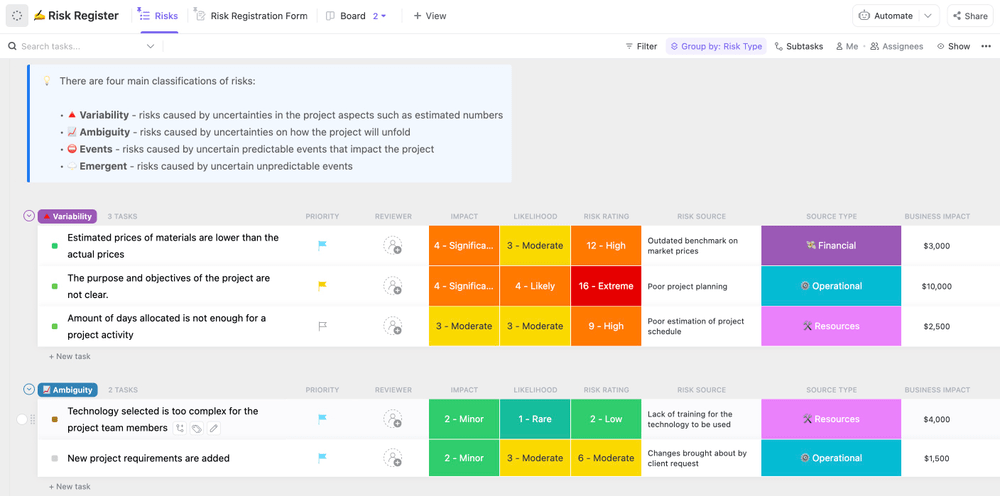
يقوم نموذج ClickUp لتحليل مخاطر إدارة المشاريع بتركيز مخاطر المشروع بحيث يمكنك التخفيف من حدة المشاكل بناءً على درجة خطورتها أو مدى إلحاحها أو تكلفتها أو عوامل أخرى
10. إدارة المشاريع ذات السلسلة الحرجة (CCPM)
بينما تركز تقنية إدارة المشاريع ذات السلسلة الحرجة فقط على إدارة تسلسل المهام على المسار الحرج، فإن إدارة المشاريع ذات السلسلة الحرجة تعدل المسار الحرج من خلال حساب توافر الموارد والقيود، مما يؤدي إلى السلسلة الحرجة.
ويتمثل هدفك من خلال إدارة السلسلة الحرجة في ضمان بقاء السلسلة الحرجة دون انقطاع من خلال تخصيص الموارد بشكل استراتيجي، وإعادة جدولة المهام التي تحتاج إلى موارد محدودة في وقت واحد، وإضافة مخازن مؤقتة لحماية المهام من التأخير.
قم بتطبيق هذه التقنية في المشاريع التي تكون فيها الموارد (مثل أعضاء الفريق المتخصص والمعدات) محدودة والتسليم في الوقت المناسب أمر لا بد منه.
5 قوالب إدارة المشاريع
تتطلب إدارة المشروع بكفاءة توازنًا بين التقنية والأدوات الموفرة للوقت مثل قوالب إدارة المشاريع . لقد جمعنا لك خمسة من أفضلها لمساعدتك في تخطيط مشاريعك وإطلاقها وتتبعها بسهولة.
1. نموذج نهج إدارة مشروع ClickUp لإدارة المشاريع

ابدأ مشاريعك مع ClickUp - ما عليك سوى ملء وتخصيص وتنفيذ
الـ نموذج نهج ClickUp لإدارة المشاريع هو قالب مناسب للمبتدئين ل تخطيط خرائط طريق المشروع من جميع الأحجام، خاصة تلك التي يمكن تنفيذها باستخدام تقنية الشلال.
ابدأ الأمور بإدخال هذه التفاصيل الرئيسية للمشروع في وصف القالب للتأكد من أن الجميع على نفس الصفحة:
- عنوان المشروع
- العميل/المؤسسة
- مدير المشروع
- الجهة الراعية
- تاريخ آخر مراجعة
- الإطار الزمني
في طريقة عرض القائمة، أضف المهام ضمن مجموعات المتطلبات والتحليل والتصميم والتنفيذ والاختبار والنشر. قم بتعيين المهام لفريقك، وحدد تواريخ الاستحقاق، وأرفق أي ملفات ذات صلة قد يحتاجها فريقك.
هذا القالب، مثل جميع قوالب ClickUp، قابل للتخصيص بالكامل. قم بتعديل السجلات وتعديل الحقول المخصصة وإضافة طرق عرض المشروع كما تراه مناسبًا!
2. قالب إطار عمل إدارة مشروع ClickUp
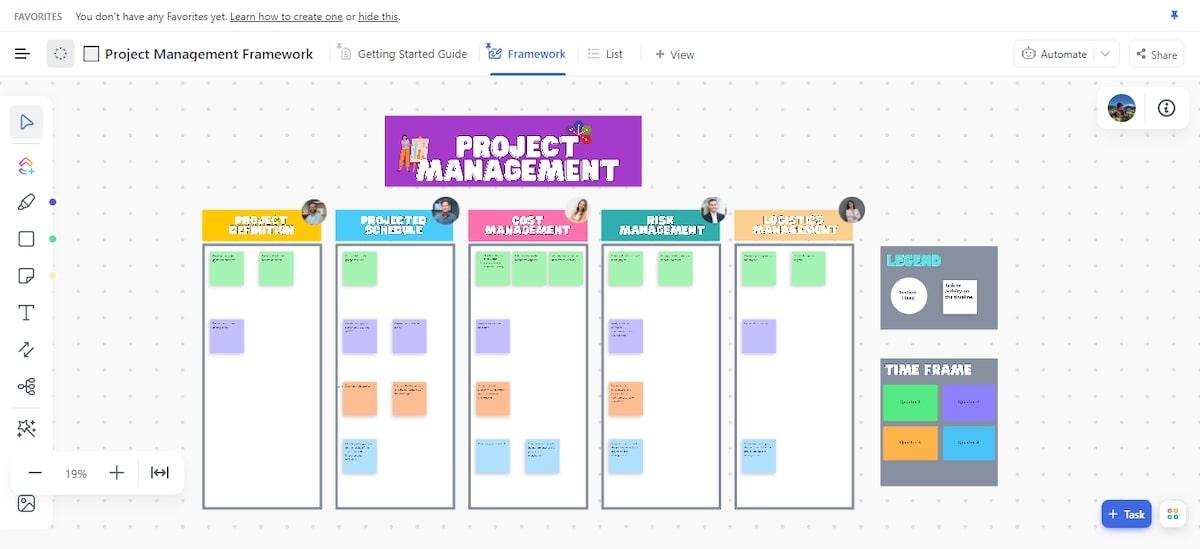
حدد مجالات التركيز الرئيسية لمشروعك وقم بترميزها بالألوان باستخدام قالب إطار عمل إدارة المشروع الخاص ب ClickUp قالب إطار عمل إدارة المشاريع الخاص ب ClickUp عبارة عن لوحة بيضاء رقمية يمكنك من خلالها تحديد مجالات التركيز الرئيسية لمشروعك. وهذا يشمل تعريف المشروع، والجدول الزمني المتوقع، وإدارة التكاليف، وإدارة المخاطر، وإدارة الخدمات اللوجستية.
خصص كل مجال من مجالات التركيز لأحد أعضاء الفريق واستخدم الملاحظات اللاصقة لتقسيم المهام لكل مجال من مجالات التركيز. قم بترميز الملاحظات اللاصقة بالألوان بناءً على حالة المهمة (تم، قيد التنفيذ، اكتمل)، أو الأولوية (عالية، متوسطة، منخفضة)، أو الإطار الزمني الذي سيتم تنفيذها فيه (مثل الأرباع 1 و2 و3 و4).
إذا كنت تبحث عن مساحة مرنة للعصف الذهني للفريق وإنشاء رؤية واضحة وكبيرة لمشروع معقد، فقد يكون هذا القالب مناسبًا لك.
3. قالب خطة مهام إدارة مشروع ClickUp لإدارة المشاريع
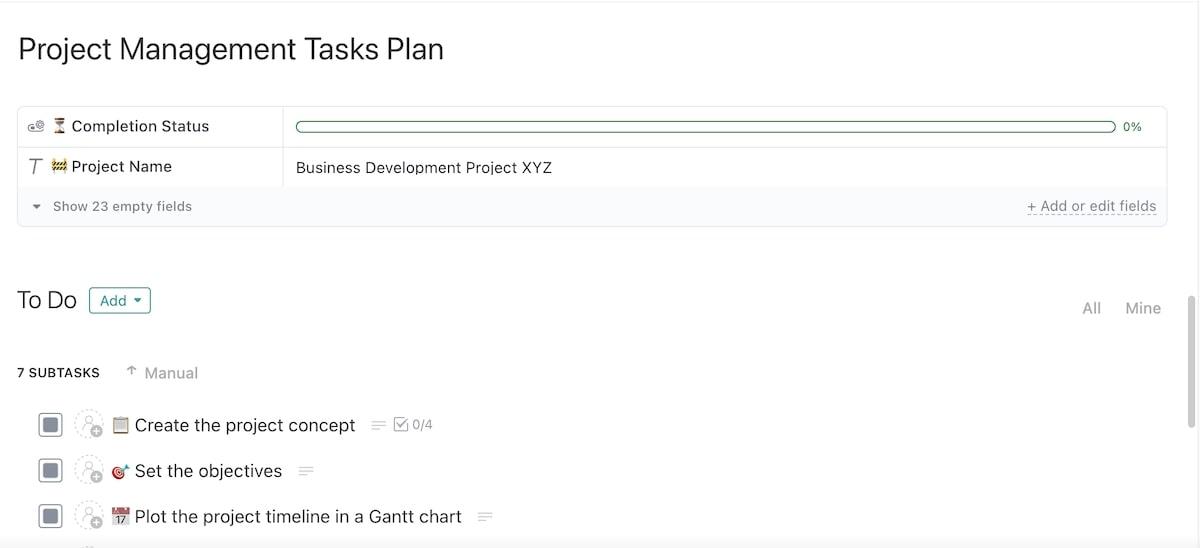
احرص على أن يبدأ مشروعك بداية سلسة مع قالب خطة مهام إدارة المشاريع من ClickUp
نموذج قالب خطة مهام إدارة مشروع ClickUp لإدارة المشاريع هو في الأساس خارطة طريق لمرحلة التخطيط لمشروعك. وهو يسرد جميع الخطوات التي تحتاج إلى اتخاذها، بدءًا من تحديد هدف مشروعك إلى تخطيط الجدول الزمني للمشروع على مخطط جانت وتقدير ميزانية المشروع. 💰
قم بتعيين كل خطوة لعضو في الفريق وحدد موعدًا نهائيًا لها. بالإضافة إلى ذلك، اجعل من السهل البقاء على المسار الصحيح من خلال تقسيم كل مهمة إلى مهام فرعية وقوائم مراجعة. على سبيل المثال، عند إنشاء مفهوم المشروع، تغطي قائمة المراجعة مجالات مثل خلفيته وأهميته, نطاق المشروع وأصحاب المصلحة
انتقل إلى عرض اللوحة لمعرفة المهام التي لم يبدأها فريقك بعد، والمهام التي لم تبدأ بعد، والمهام التي هي قيد التنفيذ، والمهام التي تم إنجازها. وبهذه الطريقة، يتم التخطيط بسلاسة وفي الوقت المحدد، حتى يبدأ المشروع الفعلي بسلاسة.
4. قالب لوحة معلومات إدارة مشروع ClickUp لإدارة المشاريع
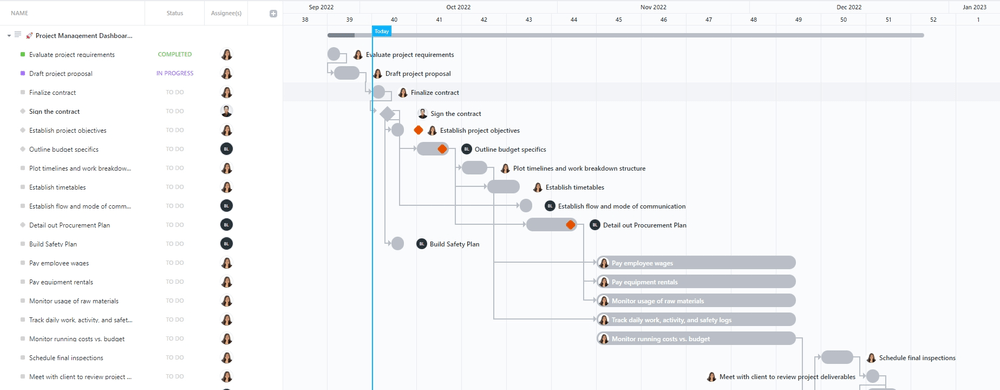
استخدم قالب لوحة معلومات إدارة المشروع من ClickUp لإدارة مشروعك وتتبع إنتاجية الفريق وموازنة أعباء العمل في مكان واحد
قالب قالب لوحة معلومات إدارة المشاريع ClickUp هي أداة مفيدة لإدارة دورة حياة مشروعك بأكملها مع الاطلاع على إنتاجية فريقك وأدائه.
نظّم أنشطة مشروعك في مراحل مختلفة: الاستهلال والتخطيط والتنفيذ والإغلاق. بالنسبة لكل مهمة، حدد المسؤول عن الوفاء بالموعد النهائي والمخاطر المحتملة والتكاليف المخططة/الفعلية لكل مهمة.
لمعرفة من يعمل على ماذا، قم بالتبديل إلى طريقة عرض الفريق وعبء العمل. يتيح لك القالب أيضًا تصور كيفية توزيع المهام على فريقك. يساعد ذلك على تحقيق التوازن بين أعباء العمل لضمان عمل الجميع بأفضل طاقاتهم.
5. قالب جدول بيانات إدارة مشروع ClickUp لإدارة المشاريع

يسهّل قالب جدول بيانات إدارة المشاريع ClickUp لإدارة المشاريع إدارة المشاريع في عرض ديناميكي على غرار جدول البيانات
إذا كنت من محبي جداول البيانات، فسوف تحب إدارة المشاريع باستخدام قالب جدول بيانات إدارة المشاريع ClickUp .
داخل عرض الجدول ، اسحب الأعمدة وأفلتها للحصول على تخطيط مخصص، أو قم بإخفاء الأعمدة التي لا تحتاج إليها، أو قم بتثبيت الأعمدة المهمة للوصول السريع. أو قم بالتبديل إلى طرق العرض الأخرى، مثل كانبان وجانت والتقويم، واجعل تفاصيل مهمتك تتزامن بسلاسة عبرها جميعًا.
بالنسبة لسير عمل الموافقة، اطلب من أعضاء فريقك تحديث حالة الموافقة على كل مهمة إلى جاهز للموافقة عند الاقتضاء. بعد المراجعة، قم بتحديث حالة المهمة إلى جاهز للمراجعة أو أعطها الضوء الأخضر بـ موافق عليه. 🚦
استخدم طريقة عرض المشكلات لترتيب مشكلات المهام حسب الخطورة، من الأقل إلى الأعلى. وبالمثل، تتيح لك طريقة عرض المخاطر رؤية المهام حسب مستوى المخاطر، من عالية إلى منخفضة، أو حتى بدون مخاطر. تسهل كلتا الطريقتين اكتشاف المشاكل ومعالجتها حتى يبقى مشروعك على المسار الصحيح.
تنفيذ إدارة المشروع دون عناء مع ClickUp
يعتمد كل مشروع ناجح على تقنيات فعالة لإدارة المشاريع. لن تناسب كل تقنية كل مشروع، لذا قم بتقييم احتياجات مشروعك بعناية واختر المزيج المناسب وفقًا لذلك.
مع ClickUp، أصبح تطبيق هذه التقنيات بسيطًا ومباشرًا للغاية. وباعتباره برنامجًا مخصصًا لإدارة المشاريع، فإنه يتولى المهام الشاقة حتى تتمكن من التركيز على استراتيجية المشروع، وتلبية أهداف إدارة المشروع وإثارة إعجاب أصحاب المصلحة والعملاء. 🤩 اشترك في ClickUp اليوم وجرِّب ميزات المنصة مجانًا.

